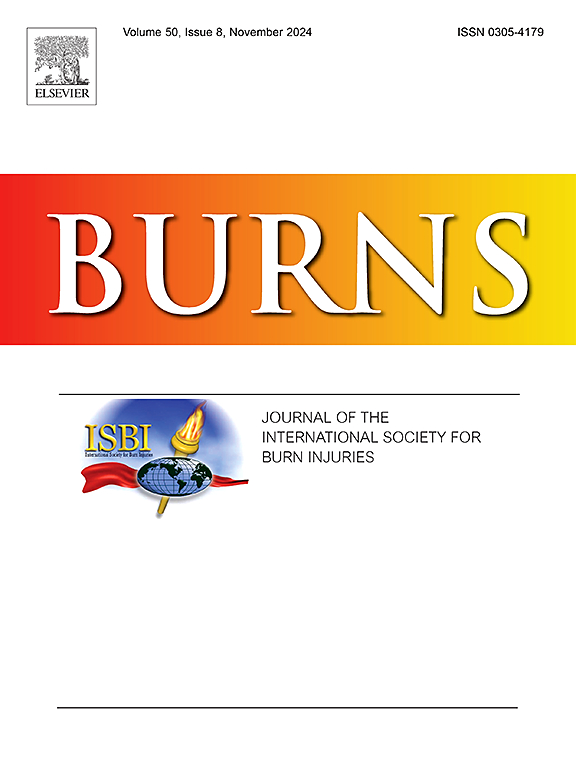Mixed grafting of small auto- and cryopreserved allo-skin for residual wound repair in severe burn patients: A retrospective study
IF 3.2
3区 医学
Q2 CRITICAL CARE MEDICINE
引用次数: 0
Abstract
Background
The wound repair process for extensively deep burn patients is a recurring and highly challenging endeavor. A prolonged healing time beyond 3 weeks after injury often leads to compromised healing outcomes. The limited availability of autologous skin grafts remains the primary obstacle in achieving timely wound repair. This study aimed to investigate an approach that minimizes the reliance on autologous skin grafts for repairing residual wounds in severe burn patients.
Methods
This was a retrospective review of 74 burn patients with large residual wounds in the middle- and late-stages of treatment who were admitted to the Burn Center of the First Affiliated Hospital of Naval Medical University between 2012 and 2022. Mixed grafting of small auto- and cryopreserved allo-skin was used in 32 patients with an expansion ratio of 1:9–16. Routine microskin grafting was applied in 17 cases with an expansion ratio of 1:10–15. Meek grafting was employed in 25 patients with an expansion ratio of 1:4–6. The main outcomes of this study were the wound healing rate and scar formation.
Results
The wound healing rate in the mixed grafting group was significantly greater than that in the microskin and Meek grafting groups (89 ± 5.8 % vs. 66.5 ± 6.9 % and 75.4 ± 5.1 %, respectively; P < 0.001). Multiple linear regression analysis showed that under the same conditions, the wound healing rate of microskin grafting and Meek grafting decreased by 24.6 % and 16.8 % compared with mixed grafting respectively. Follow-up studies of 43 of total 74 burn patients over 1–2 years revealed that the mean VSS scores for pigmentation, pliability, scar height, and vascularity in the mixed grafting group (n = 23) were significantly lower (total score 4.23 ± 2.17) than those in the microskin grafting group (n = 12; 6.02 ± 2.73, P = 0.03), and not significantly different from those in the Meek grafting group (n = 18; 4.37 ± 2.13, P = 0.74).
Conclusions
Mixed grafting of small auto- and allo-skin minimizes the reliance on limited autologous skin resources while achieving superior healing rates and lower scar formation for repairing deep burn wounds. Compared with the microskin and Meek grafting methods, the mixed grafting approach significantly enhances wound healing rates and outcomes in patients with extensive deep burns. Our findings suggest that mixed grafting is a viable and effective strategy for improving wound repair and functional outcomes in severely burned patients.
自体小皮与低温保存同种异体皮混合移植用于严重烧伤患者残留创面修复的回顾性研究。
背景:广泛深度烧伤患者的创面修复是一个反复出现且极具挑战性的过程。损伤后愈合时间延长超过3周通常会导致愈合效果受损。自体皮肤移植的有限可用性仍然是实现及时修复伤口的主要障碍。本研究旨在探讨一种减少严重烧伤患者对自体皮肤移植修复残余创面依赖的方法。方法:回顾性分析2012 - 2022年海军医科大学第一附属医院烧伤中心收治的74例中晚期大面积残留创面烧伤患者的临床资料。采用自体小皮与低温保存异体皮混合移植32例,扩张比为1:9 ~ 16。常规微皮移植17例,扩张比1:10-15。25例患者采用Meek移植,扩张比1:4-6。本研究的主要结果是伤口愈合率和疤痕形成。结果:混合移植组伤口愈合率明显大于microskin和温顺的移植组(89 ± % 5.8 vs 66.5 ±6.9 %和75.4±5.1 %,分别;P 结论:小块自体皮和异体皮混合移植在修复深度烧伤创面时,可最大限度地减少对有限的自体皮资源的依赖,同时具有较高的愈合率和较低的瘢痕形成。与微皮肤和Meek移植方法相比,混合移植方法显著提高了大面积深度烧伤患者的创面愈合率和预后。我们的研究结果表明,混合移植是改善严重烧伤患者伤口修复和功能预后的可行和有效的策略。
本文章由计算机程序翻译,如有差异,请以英文原文为准。
求助全文
约1分钟内获得全文
求助全文
来源期刊

Burns
医学-皮肤病学
CiteScore
4.50
自引率
18.50%
发文量
304
审稿时长
72 days
期刊介绍:
Burns aims to foster the exchange of information among all engaged in preventing and treating the effects of burns. The journal focuses on clinical, scientific and social aspects of these injuries and covers the prevention of the injury, the epidemiology of such injuries and all aspects of treatment including development of new techniques and technologies and verification of existing ones. Regular features include clinical and scientific papers, state of the art reviews and descriptions of burn-care in practice.
Topics covered by Burns include: the effects of smoke on man and animals, their tissues and cells; the responses to and treatment of patients and animals with chemical injuries to the skin; the biological and clinical effects of cold injuries; surgical techniques which are, or may be relevant to the treatment of burned patients during the acute or reconstructive phase following injury; well controlled laboratory studies of the effectiveness of anti-microbial agents on infection and new materials on scarring and healing; inflammatory responses to injury, effectiveness of related agents and other compounds used to modify the physiological and cellular responses to the injury; experimental studies of burns and the outcome of burn wound healing; regenerative medicine concerning the skin.
 求助内容:
求助内容: 应助结果提醒方式:
应助结果提醒方式:


